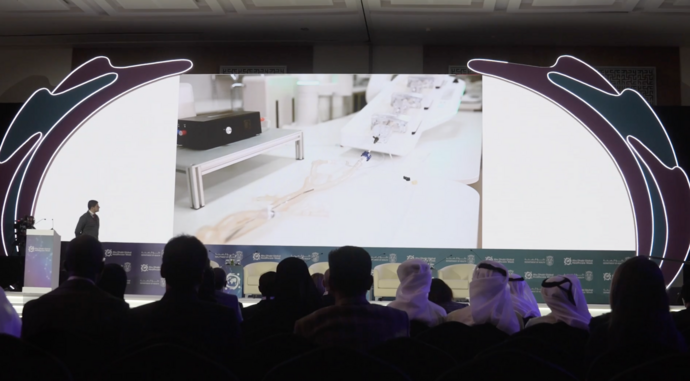XCath, an early-stage medical device company dedicated to expanding endovascular treatment procedures through smart steerable guidewires and robotic systems, part owned by UAE-based Crescent Enterprises, showcased a first-of-its-kind live telerobotic trial for stroke treatment between Abu Dhabi and Korea.
In a presentation at Abu Dhabi Global Healthcare Week (ADGHW), Dr Vitor Mendes Pereira, neurosurgery pioneer and Director of Endovascular Research and Innovation at St. Michael’s Hospital, University of Toronto, Canada, successfully performed a mechanical thrombectomy (blood clot extraction from a blood vessel) procedure from Abu Dhabi on a simulated patient in South Korea. Dr Pereira performed the surgery live, with a simulated patient situated in Korea and streamed over a live feed. The surgery was performed within minutes at low latency and used a microcatheter to remove a simulated blood clot in a brain vessel.
Time is critical in treating stroke patient outcomes, as the patient risks losing more than 2 million brain cells per minute until treatment is administered. Telerobotic surgery enables a way to save valuable time and bring expertise to remote places around the world. By supporting remote minimally invasive procedures, the XCath platform can expand treatment options and improve patient outcomes for acute neurovascular conditions.
Eduardo Fonseca, CEO of XCath, said: "This successful telerobotic demonstration marks a key validation of our platform’s potential to improve treatment of emergent conditions like stroke. As one of the leading advocates for telerobotic technology, Dr Pereira was able to demonstrate how our technology could be used to transform patients’ lives across the globe."
Dr Fred Moll, surgical robotics pioneer and Founder of Intuitive Surgical said: "Today, we witnessed a groundbreaking moment with the world’s first telerobotic manual thrombectomy on a model, from Abu Dhabi to Seoul. This pioneering achievement is not just a first, but a crucial stepping stone towards regulatory and industry support, ultimately leading to widespread acceptance and adoption. In the field of endovascular care, particularly in stroke treatment where every minute counts, this technology holds transformative potential."
The simulated live thrombectomy case, conducted during Abu Dhabi Global Healthcare Week 2024, examined the latency, and overall performance of the remote setup.
Dr Pereira performed the telerobotic operation using a robotic controller located in Abu Dhabi, while the silicone model and the bedside unit were situated in South Korea, 6,949 kilometres from the conference hall in Abu Dhabi. The neurovascular devices used were Stryker AXS Infinity LS, Trevo Trakb21 and Trevo NXT.
Communication between the robotic controller and the bedside unit used the standard conference ethernet connection with the possibility of 5G redundancy, rather than dedicated lines. The latency experience during the procedure ranged from 153 milliseconds to 170 milliseconds, with an average latency of 160 milliseconds. Jitter was measured and found to be imperceptible.
During the session XCath presented the company’s navigation challenges and showcased an overview of its robotic platform. The presentation highlighted the transformative impact of the endovascular revolution for Abu Dhabi institutions, illustrating how advanced robotic treatment can make the UAE a centre for transformational clinical outcomes.
Neeraj Agrawal, Executive Director of Crescent Enterprises, said: "Successful execution of the world’s first telerobotic manual thrombectomy on a model between Abu Dhabi and Seoul Korea at Abu Dhabi Healthcare Week is a testament to the UAE’s dedication to pioneering futuristic technologies. This remarkable progress from XCath highlights the regions leadership in the global medical arena and Crescent Enterprises’ commitment to driving innovation in healthcare."










